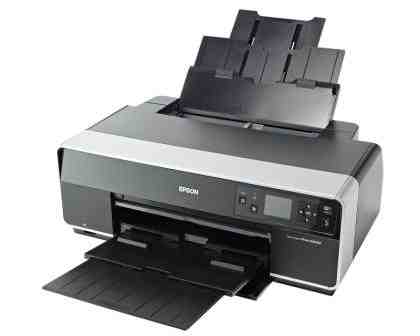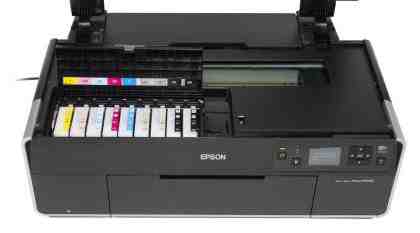The Epson Stylus Photo R3000 A3+ photo printer takes nine ink cartridges, including three different photographic inks which help to ensure optimal performance in black and white prints: photo black, light black and light light black. By comparison, the cheaper Stylus Photo R2000 has only photo black and grey for its greyscale image production. The R3000 also has the usual cyan, magenta and yellow inks, along with light cyan and light magenta variations. There’s also a matt black cartridge for plain paper printing.

You have to manually configure the printer to use either matt black or photo black depending on what kind of paper you're printing on. The Windows driver will inform you if the printer is currently set to an ink type other than the one you've selected for your print in your application's print properties menu.
You switch between the ink types using the printer's built-in menu. This is easy to find via the integrated colour LCD screen, but we'd prefer it if the printer could change modes automatically. That said, most users will be printing either photos or matt art prints in large batches, reducing the need to constantly switch between the two. Changing ink type takes a few minutes while the ink system reloads itself and consumes some of your ink in the process.

The R3000, like most other serious photo printers, isn't designed with document printing in mind. However, it handles plain paper documents well. Print speeds are still rather slow, but quality is good and we had no trouble loading paper. There are only two quality modes available for plain paper prints: Speed (draft quality) and Quality (high quality). We recommend making all prints in Quality mode, as draft mode wasn't all that fast at 5.4ppm and produced grey text with rather jagged edges. Quality mode produced print speeds of 2.3ppm for mono text and a somewhat agonising 1.6ppm for colour prints. In this mode, both mono text and our illustrated business documents looked fantastic, but its cost and slow speed mean that the R3000 will never be anyone’s first choice for document printing.
When printing photos, you can choose from five different quality settings, but we recommend opting for Max Quality printing to ensure the best possible photos rather than attempting to save a few pennies to reduce printing time or save on ink. Print speeds are a little slow, even for a high resolution photo printer, with an A3 print emerging in nine minutes and four seconds and 6x4in photos taking two minutes and 14 seconds each. 10x8in prints took four minutes apiece.
The most obvious difference between prints from the R3000 and those from the cheaper Stylus Photo R2000 is in the R3000’s superior rendition of subtle variations in dark colours and the level of detail visible in its reproduction of low-contrast areas. Colourful tones of fruits and flowers are bright and vivid, without appearing unnatural, while black areas in our test prints looked fantastic in side-by-side comparisons with prints from cheaper Epson printers, although they weren’t quite as rich as those from similarly priced pigment ink-based Canon printers.
The R3000 uses pigmented inks, which lay particles down on the surface of the page, rather than soaking in like dye-based inks. Pigmented inks tend to result in sharper, more durable photos, but can also look a little dull. Even though the R3000 doesn’t have a clear overcoat cartridge such as those used by Canon’s pigment-based inkjets, we were pleasantly surprised by the glossy finish of photos printed on Epson’s Premium Glossy paper, while those printed on lustre paper had a more traditional semi-gloss art print look.